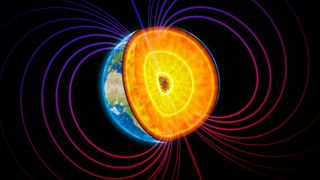Earth's outer core may hold a hidden 'doughnut'
A newly discovered doughnut shape in Earth's outer core may reveal elements that help drive the formation of the planet's magnetic field.

A newly discovered "doughnut" in Earth's core could influence the planet's magnetic field.
In a new study, researchers observed the doughnut-shaped structure for the first time by looking at reverberations of large earthquakes many hours after the quakes occurred. They found an odd ring around the outer core's equator, where earthquake waves move more slowly than in surrounding regions.
Earth's outer core is made up of liquid iron and nickel and surrounds the solid inner core. Its churning movements create Earth's magnetic field, which surrounds the planet and shields it from solar particles and cosmic radiation. The new findings, published Aug. 30 in the journal Science Advances, may help explain how the outer core moves and mixes, giving rise to this planetary armor. Specifically, the slowed seismic rays may be a result of lighter elements in the outer core, study co-author Hrvoje Tkalčić, a geophysicist at Australian National University, said in a statement.
The only way to measure Earth's core is through the movement of earthquake waves that bounce from one side of the globe to the other. These seismic studies have shown that the core is a bit less dense than pure iron. Geoscientists thus debate which light elements — such as carbon, oxygen, hydrogen and silicon — might be present, and in what quantities.
"These light elements, alongside temperature differences, help stir liquid in the outer core," Tkalčić said.
Previous studies of the outer core's structure had looked only at waves in the first hour or so after a large earthquake, Tkalčić said in the statement. He and his colleagues studied the reverberations over many hours, giving them more complete coverage of the outer core's area. More studies with a wider field of view are still needed to confirm the structure's existence, the research team wrote in their paper.
The strength and orientation of Earth's magnetic field vary over time, and researchers don't yet understand the full reasons for these changes. Therefore, the precise ingredients in the possible outer-core doughnut could be important for understanding the relationship between a planet's core and its magnetic field.
Sign up for the Live Science daily newsletter now
Get the world’s most fascinating discoveries delivered straight to your inbox.
"The magnetic field is a fundamental ingredient that we need for life to be sustained on the surface of our planet," Tkalčić said. "The dynamics of Earth's magnetic field is an area of strong interest in the scientific community, so our results could promote more research about the magnetic field on both Earth and other planets."

Stephanie Pappas is a contributing writer for Live Science, covering topics ranging from geoscience to archaeology to the human brain and behavior. She was previously a senior writer for Live Science but is now a freelancer based in Denver, Colorado, and regularly contributes to Scientific American and The Monitor, the monthly magazine of the American Psychological Association. Stephanie received a bachelor's degree in psychology from the University of South Carolina and a graduate certificate in science communication from the University of California, Santa Cruz.
Most Popular


